
Guests
- Peter Coyotepolitically engaged actor and writer, ordained Zen Buddhist priest and a longtime friend of imprisoned Native American leader Leonard Peltier.
In a renewed push, President Obama is being urged to grant clemency to the legendary Native American activist Leonard Peltier, who has spent 37 years in prison. On Friday, singers Harry Belafonte and Pete Seeger will host a “Bring Leonard Peltier Home in 2012 Concert” at the Beacon Theatre in New York City to raise awareness of Peltier’s 37-year ordeal and plea for executive clemency from Obama. We’re joined by the acclaimed actor and narrator Peter Coyote, a longtime friend and advocate of Peltier. Coyote is a politically engaged actor and writer as well as an ordained Zen Buddhist priest. He recently narrated the recent Ken Burns mini-series, “The Dust Bowl.” [includes rush transcript]
Transcript
AMY GOODMAN: Our guest for the rest of the hour, Peter Coyote, politically engaged actor and writer, ordained Zen Buddhist priest, longtime friend of imprisoned Native American leader Leonard Peltier. He is the well-known voice of so many of Ken Burns’ documentary series, most recently Dust Bowl, and before that, Prohibition, coming up, The Roosevelts, now here to talk about Leonard Peltier, because a major concert is being held in Peltier’s honor Friday night to bring attention to the Native American leader’s case, in prison now in Florida, but overall in prison for more than 37 years. If he served out his term—he was convicted for killing two FBI agents on the Pine Ridge Reservation in 1975. If he served out his term, he would be out when he was 95 years old.
Peter Coyote, why did you get involved with this case? Can you tell us the story of Leonard Peltier?
PETER COYOTE: Sure. I’ll put that in a nutshell. I do want to say, he was not convicted for killing the agents. He was convicted of aiding and abetting, and even the government has admitted they have no idea whether he killed the agents or not.
So, I met Leonard long before he went to jail. I was involved in some Native issues before Wounded Knee. And a young friend of mine who was in charge of the spiritual elders came through, and they needed to buy some weapons for Wounded Knee, to defend. And I used to be a marksman; I know a lot about guns. I went to do that.
AMY GOODMAN: And they were allowed to have guns on the reservation.
PETER COYOTE: Oh, yeah. Yeah. So, traveling with them was this guy known as Alex, this big guy. We ran around for a couple of weeks, getting together some guns and ammunition and stuff like that. And several years later, I read an article in Akwesasne Notes about Leonard Peltier. I had no idea it was the same person. But I routinely send commissary money to people in jail that I know or that I’m impressed by, so they can buy some candy and cigarettes and stuff. I get this long letter back, “Hey, I knew this guy Coyote. He used to have a blue-eyed coyote dog and had this truck, and we did this and that. You knew me as Alex.” So, I got goosebumps, and I thought, “I’ve got to get on board.”
So here’s the case in a nutshell. 1973, the highest per capita murder rate in the United States was the Sioux Indian reservation. Over 70 democracy activists were murdered by the chief of tribal police, Dick Wilson, who called his police force the ”GOON Squad.” The traditional women—
AMY GOODMAN: That’s GOON, Goons—
PETER COYOTE: Yeah, Guardians of Oglala Nation. But they were, you know, being sadistic puns.
So the traditional women requested the American Indian Movement warriors to come in, and a cadre of men and women came in and set up a camp on the Jumping Bull Ranch. It was in this climate of murder and intimidation that an unmarked car drove onto the reservation one day. Two guys get out, and they get long guns out of the back. In retrospect, it turns out they were FBI agents, and they claimed they were following a kid who had stolen some cowboy boots onto the reservation—hardly a federal crime. They had 50 tribal police just off the Jumping Bull Ranch. And what most people suspect is that it was a diversion, because the tribal police chief, Dick Wilson, was in Washington illegally signing away the uranium mining rights of the tribe.
So, a gunfight got started. No one knows how it got started. The tribal police fled. The FBI men were surrounded, they were wounded, and they were then executed. When they searched the bodies and they found out that they were FBI men, they were terrified, and the leadership knew what was coming, and they fled. And, in fact, the reservation was taken over by government forces. They fired 100,000 rounds of ammunition. They stripped Native elders naked. They broke down houses. They arrested three people for the crime, and they were acquitted by an all-white jury in South Dakota. And the government went crazy. So they got together, and they stitched up all the loopholes in the case. And they did it by fabricating chains of evidence, by suborning witnesses, by filing false affidavits. And they went, and they got Leonard. And when Leonard’s trial was appealed, there was—
JUAN GONZÁLEZ: So he was not part of the first three originally accused.
PETER COYOTE: Not at all. He was not part of the three at all. They went after him. The Canadian government is still suing the United States for filing false affidavits, which were responsible for his extradition. So they brought him down. They tried him. They made it look like an iron, bullet-proof case against him, and they imprisoned him.
At his appeal, the 8th Circuit Court of Appeals, a fellow named Judge Heaney wrote this list of 10 egregious errors in the trial, but said, “My hands are tied. I have to find him guilty.” But he personally wrote to President Clinton asking for clemency for Leonard and said the FBI was culpable in this case, said—
AMY GOODMAN: The judge in the case.
PETER COYOTE: The judge, Judge Heaney, did that. So, my argument is, since I was not there, I didn’t witness it—I was told by people who were there that Leonard was minding the children. The man who actually executed the agents has admitted it. He spoke to author Peter Matthiessen. He was masked. He said, “We were at war. I don’t see why I should turn myself in. But I executed these people. This is what happened.” So, my argument is, since I wasn’t there, since I can’t personally certify that Leonard Peltier didn’t do this, I’m arguing that no American deserves a trial like this, that when the government—when the federal prosecutor, whose name was Crook, stood up several years ago and said the government has no idea who committed the murders, Leonard Peltier should have been released.
In 1996, the Democratic Party asked me to be a delegate. And I said, “Well, I’ll do that if you’ll give me an introduction to a deputy level or above in the Justice Department.” So I went to the convention, and they like celebrities because they get the cameras. And so they introduced me to a deputy level, and I briefed him on the case. And he said, “I’ll have to get back to you.” And he called me two days later, and he said, “Mr. Coyote, I’m embarrassed to tell you this. When you spoke to me, I thought you were a wild-eyed radical. I’m embarrassed to tell you that everything you said is true, and all I’m at liberty to say to you is that there are some very powerful people who don’t want Leonard Peltier out of jail.” And I said, “Would their initials be W.W.?” meaning William Webster, head of the FBI? And he said, “Well, you said that.”
So, I think he has been held vindictively as the scapegoat for the deaths of two agents—that’s terrible, it’s unfortunate. What were they doing on the reservation, driving into an armed camp? They were obviously preparing to spring a trap. These are high-stakes games. Leonard’s aunt was run over and left dead on the side of the road. That’s how he came there. Leonard was an urban Indian from Seattle. He’s the guy that would fix everybody’s car for nothing and make sure that people had something to eat. He’s hardly a firebrand. And he’s become the Nelson Mandela of the Native movement through his courage and growth and incarceration. And I’m one of the people who has known him since before he went to jail. So, I marvel at this change and deepening.
JUAN GONZÁLEZ: And you said that in prior attempts to try to get clemency for him, that actually the movement has not really understood the enormous influence that the FBI has in Washington in terms of every time that the movement sparks up and there’s huge protest and outcry, the FBI goes around to congressional offices and to the White House advocating to keep him in jail.
PETER COYOTE: I can tell you this personally. I don’t want to—I don’t want to make dissension among the left, people I respect, but I was involved in the clemency petition to Clinton, helped brief the people. We sent a producer in, who convinced the president’s lawyer, who said, “You’ve convinced me. Now you have to write the speech for Clinton.”
AMY GOODMAN: The president’s lawyer was?
PETER COYOTE: Silver—Bruce—sorry, Uncle Dribble is losing his frontal lobes. Anyway, but he got it. We laid out all the evidence. I was not in the room. Someone else went in, a big money guy. And so, I called the Leonard Peltier Defense Council, which is being run by a woman, very active and able organizer, whose husband had been murdered, and I said, “Listen, this is an appeal to an audience of one. Do not go for public opinion. Let’s go in under the radar. Let’s not notify the FBI.” I can’t really blame her for not trusting me, for, you know, their—everything they’ve gained has come from social action. And here’s this Jew with an animal name saying, “Trust me, I’ll make it alright.”
So, I went to Congress. And they were out in the streets with their signs, and literally every congressional office I went into, as I was going in, the FBI was leaving with pictures of the dead agents that they had been showing on the congressmen. I could do nothing. And what I was told—and this is apocryphal—but I was told that it was Tom Daschle who went to Clinton, who was in a very tough race for his re-election, and he said—
AMY GOODMAN: In South Dakota.
PETER COYOTE: Yeah. “If you free Leonard Peltier, you’ll have a Republican senator in South Dakota.” So that’s the scuttlebutt that we got.
AMY GOODMAN: I want to turn to Lynn Crooks, an assistant U.S. attorney who helped put Leonard Peltier in prison. He was—
PETER COYOTE: Who was the one that said, “We don’t know if he did it or not.”
AMY GOODMAN: He was interviewed by Tony Jones of Australian Broadcasting.
LYNN CROOKS: The trial was a long, hard trial, about five weeks. When we got all through with it, we wound up with no eyewitnesses. There were no direct testimony to “I saw Leonard Peltier finish off the agents.” We had basically tried it on a kind of a combined hybrid theory. Our main theory, obviously, was that Leonard Peltier had gone down and personally executed both agents. I mean, there’s no question that that was our main theory. But we hadn’t proved that, and we knew we hadn’t prove it. And so, we argued it to the jury quite simply as, “Ladies and gentlemen, this is what we think he did, but we know we didn’t prove that, but, you know, we think we’ve convinced you that he did.”
TONY JONES: You told the appeal judges in 1986, “We can’t prove who shot those agents.”
LYNN CROOKS: Well, again, you’re talking semantics.
TONY JONES: No, what I’m talking about is a contradiction between two statements.
LYNN CROOKS: If you’re talking—if you’re talking about, did we have an eyewitness, did we prove by irrefutable evidence that he was the person that squeezed the trigger, we had never claimed that we had proved it in that sense.
TONY JONES: But that’s what you told the jury. And if I can quote from your closing argument, “We proved that he went down to the bodies and executed these two young men at point-blank range.”
LYNN CROOKS: Were they allowed to put the FBI on trial as they did in Cedar Rapids? No. But they were not allowed to essentially put the FBI on trial to imply that the FBI had hired Christopher Columbus to come over and harass the Indians.
AMY GOODMAN: That was Lynn Crooks, assistant U.S. attorney, who helped put Leonard Peltier in prison. Peter Coyote, if could you respond to what he said and then talk about what you’re doing this week?
PETER COYOTE: Sure. Well, as I mentioned—this Australian reporter did a better job than I did of having the testimony to the jury and then the testimony to the judge. So, this is a man who’s spent 37 years for a crime that not even the government can assert that he committed. It’s telling that we had originally planned this benefit—Jackson Browne, myself, Harry Belafonte, Pete Seeger, a host of others—at the Beacon Theatre Friday night at 7:30, and there was going to be a benefit to try to raise money to get Leonard’s lawyers re-energized, because they burn out. They’ve worked for 37 years—appeals, families shattered. I mean, it’s terrible. And Leonard stopped the benefit. He said, “After Sandy, I do not want to ask people in New York and New Jersey to give anything. Just bring my case to their attention. Let’s give it a public look again, as we go after clemency.” So that’s what we’re doing. We’re just once again into the breach, refreshing the public’s knowledge of this man, who is like Geronimo Pratt. You know, Geronimo Pratt only did 28 years, and Leonard has—
AMY GOODMAN: Until his case was overturned.
PETER COYOTE: Yes, right, exactly. So, you know, I’ve been doing this a long time. And Leonard hasn’t given up hope. I haven’t given up hope. But I go home every night. Leonard is in jail. He’s got diabetes. His health is bad. They didn’t let him out for the death of his mother. They didn’t let him out for the death of his father. They didn’t let him out for the deaths of aunts and uncles. He survived two attempts on his life in prison. His jaw was wired shut for over a year, while he waited just, you know, basic medical treatment. And I’m embarrassed to be the citizen of a country that would treat any one man this way on the basis of such a jury-rigged trial.
AMY GOODMAN: Peter Coyote, we want to end with the words of Leonard Peltier himself, with another of his poems.
LEONARD PELTIER: “I Am Everyone.”
I am everyone
who ever died
without a voice
or a prayer
or a hope
or a chance…
everyone who ever suffered
for being an Indian,
for being human,
for being indigenous,
for being free,
for being Other,
for being committed....
I am every one of them.
Every single one.
Yes.
Even you.
I am everyone.
AMY GOODMAN: Leonard Peltier, reading his own poetry, recorded by Claus Biegert, the German journalist. Peter Coyote, you have 10 seconds. You have spoken to Leonard in jail.
PETER COYOTE: My last letter from Leonard was several months ago, and he just said very plaintively, “Brother, please don’t let me die in prison.”
AMY GOODMAN: Peter Coyote, I want to thank you very much for being with us. We will link to our interview [part one, part two] with Leonard Peltier in jail. The Beacon Theatre event with Peter Coyote, Harry Belafonte, Pete Seeger and others is Friday night here in New York City on the Upper West Side at the Beacon Theatre.

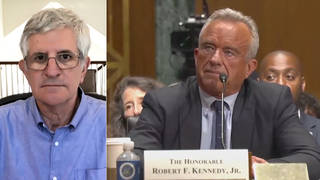
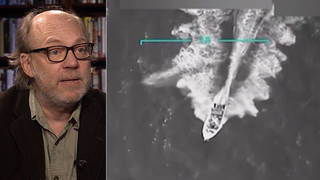
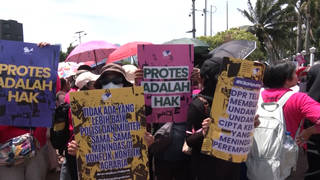

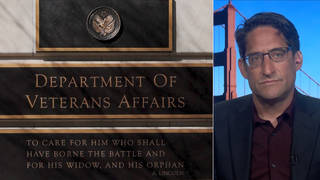
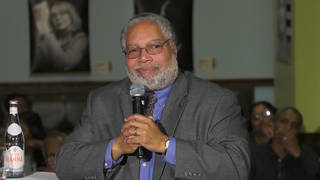

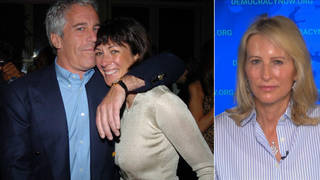


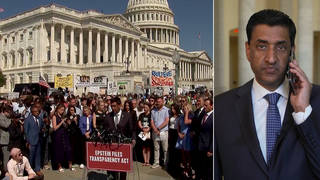
Media Options